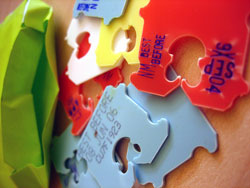 Cracking the twist-tie code for freshest bread
Cracking the twist-tie code for freshest bread
Have you noticed those little twist ties on your bread loaf? Take a moment to look at the colored twist tie? Most of the bread you'll find on U.S. supermarket shelves arrives housed in plastic wrappers closed by colored twist tags or plastic tabs. The tabs serve a purpose besides aiding in keeping the bread -- their colors provide a quick visual reference to the people whose job it is to recycle the stock by removing older loaves while loading the shelves with fresh product.
Fresh bread is delivered to retail outlets on Monday, Tuesday, Thursday, Friday and Saturday. Why are bread deliveries not made on most Wednesdays? Most commercial bakeries utilize Wednesdays for “emergency only” deliveries; customer care calls and as a day off for their drivers as they also have Saturday deliveries to make. That means most bakery drivers have a “split” weekend with Wednesdays and Sundays off.
Each day’s delivery has a different colored twist tie associated with it, these are the most common color tie designations:
|
Monday – Blue Tuesday – Green Thursday – Red Friday – White Saturday – Yellow.
|
 |
<script type="text/javascript">// <![CDATA[
google_ad_client = "pub-2970895246189115";
/* 336x280, created 12/3/10 */
google_ad_slot = "6039910414";
google_ad_width = 336;
google_ad_height = 280;
// ]]></script>
<script src="http://pagead2.googlesyndication.com/pagead/show_ads.js" type="text/javascript">
</script>
(Notice that the colors were assigned in alphabetical order.) So, if today was Thursday, you would want to purchase a loaf with a red twist tie - not a white one which was a Friday delivery (almost a week old)! This coding system has been used in the U.S. for over ten years, though some bread companies have created their own color “schemes” for their daily deliveries.
Most bread delivery personnel will tell you all about their company’s coding system should you catch them at your local store. It is a universal way for the both the store management and the re-stocking delivery person to easily pick out the loaves that need to be returned. By streamlining re-stocking and inventory, the delivery person is able to make more stops and move more efficiently. This also gives the company a better response reputation and improved bottom line.
What to do if you're absolutely determined to have only the freshest bread on your table, now that you know there's a code you're set on making use of? Contact the manufacturer of your favorite brand and ask what (if any) color-coded tag system they adhere to and what their delivery schedule to your favorite store is, then let your selection be guided by that. In the end, the best way to determine the freshness of bread maybe simply to look at the date on the loaf.
Bread Facts:
The inner part of the bread loaf encased by the crust is called the “crumb”, hence why small bits of this part of the bread are called crumbs.
Bread is one of the oldest known foods man-made with records of it going back to around 10,000 BC, which was right at the end of the Stone Age.
Ancient Egyptian governments strictly controlled the production and distribution of bread as a means of controlling the population. Bread was the primary food source for most people at the time and if bread was taken away, most people in Egypt at that time would have starved.
During the 18th century in France, one of the triggers for the French Revolution was a shortage of bread.
Millions of impoverished people around the world, survive on bread, tea, cheese, and little else. Nutritionally, bread is a very inexpensive source of calories and proteins. It can also be made from a variety of sources outside of the more standard wheat (it can also be made from bark).
Throughout history, highly refined white bread was a luxury only available to the wealthy and thus was seen as a status symbol. Breads from whole grains were only for the poor. Due to whole grain bread being relatively healthy compared to white bread, that trend has switched.
In medieval times in Western Europe, breads were typically named after the class of people who typically consumed a given type of bread. There were knight’s loafs, squire’s loafs, varlet’s loafs, court’s loafs, pope’s loafs, common loafs, table loafs, etc.
